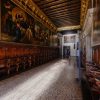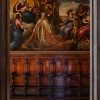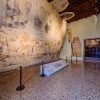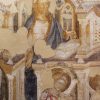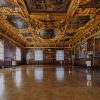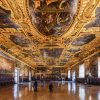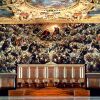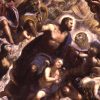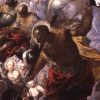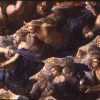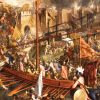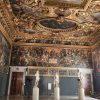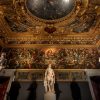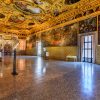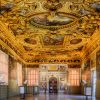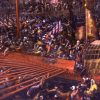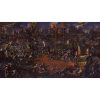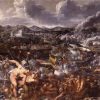Liagò. In Venetian dialect liagò means a terrace or balcony enclosed by glass. This particular example was a sort of corridor and meeting-place for patrician members of the Great Council in the intervals between their discussions of government business. The ceiling of painted and gilded beams dates from mid 16th century, while the paintings on the walls are from the 17th and 18th century. The gallery also contains three important works of sculpture: Adam, Eve and The Shield-Bearer. These are the originals sculpted between 1462 and 1471 by Antonio Rizzo to adorn the façades of the Foscari Gateway in the courtyard of the palace.
The Chamber of Quarantia Civil Vecchia. The Council of Forty (Quarantia) seems to have been set up by the Great Council at the end of the 12th century and was the highest appeal court in the Republic. Originally a single forty-man council which wielded substantial political and legislative power, the Quarantia was during the course of the 15th century divided into 3 separate Councils: the Quarantia Criminal (for sentences in what we would call criminal law); the Quarantia Civil Vecchia (for civil actions within Venice) and the Quarantia Civil Nuovo (for civil actions within the Republic’s mainland territories). This room was restored in the 17th century; the fresco fragment to the right of the entrance is the only remnant of the original decor. The paintings hanging here date from the 17th century as well.
The Guariento Room. The first name is due to the fact that this room was once linked to the Armory by a staircase, and the second name to the fact that it now houses a fresco painted for the Hall of the Great Council by the Paduan artist Guariento around 1365. Almost completely destroyed in the 1577 fire, the remains of that fresco were, in 1903, rediscovered under the large canvas Il Paradiso which Tintoretto was commissioned to paint for the same wall. Guariento’s fresco, too, depicts Paradise. In the center there is an enthroned Virgin being crowned by Christ, while, to far left and right, are aedicule like those from a portico church façade, under which one can see the figures of the Annunciation: the Angel Gabriel on the left, and the Virgin Mary on the right. Angels playing musical instruments surround the central figures and the Evangelists are shown before the throne; saints, prophets and martyrs are depicted alongside in individual stalls with gothic tracery. The heat of the fire reduced the surviving fragments to a near monochrome, while in places where the plaster has fallen, one can see the red traces of the preliminary drawing. What we have now gives a scarcely adequate idea of what must have been a sumptuous work, glittering with color and gilding.
Chamber of the Great Council. Restructured in the 14th century, the Chamber was decorated with a fresco by Guariento and later with works by the most famous artists of the period, including Gentile da Fabriano, Pisanello, Alvise Vivarini, Carpaccio, Bellini, Pordenone and Titian. 53 meters long and 25 meters wide, this is not only the largest and most majestic chamber in the Doge’s Palace, but also one of the largest rooms in Europe. Here, meetings of the Great Council were held, the most important political body in the Republic. A very ancient institution, this Council was made up of all the male members of patrician Venetian families over 25 years old, irrespective of their individual status, merits or wealth. This was why, in spite of the restrictions in its powers that the Senate introduced over the centuries, the Great Council continued to be seen as bastion of republican equality. The Council had the right to call to account all the other authorities and bodies of the State when it seemed that their powers were getting excessive and needed to be trimmed. The 1,200 to 2,000 noblemen who sat in the Council always considered themselves guardians of the laws that were the basis of all the other authorities within the State. This room also housed the first phases in the election of a new Doge, which in the later stages would pass into the Sala dello Scrutinio. These voting procedures were extremely long and complex in order to frustrate any attempts of cheating. Every Sunday, when the bells of St. Mark’s rang, the Council members would gather in the hall with the Doge presiding at the center of the podium and his counselors occupying double rows of seats that ran the entire length of the room. Soon after work on the new hall had been completed, the 1577 fire damaged not only this Chamber but also the Sala dello Scrutinio. The structural damage was soon restored, respecting the original layout, and all works were finished within few years, ending in 1579-80. The decoration of the restored structure involved artists such as Veronese, Jacopo and Domenico Tintoretto, and Palma il Giovane. The walls were decorated with episodes of the Venetian history, with particular reference to the city’s relations with the papacy and the Holy Roman Empire, while the ceiling was decorated with the Virtues and individual examples of Venetian heroism, and a central panel containing an allegorical glorification of the Republic. Facing each other in groups of six, the twelve wall paintings depict acts of valor or incidents of war that had occurred during the city’s history. Immediately below the ceiling runs a frieze with portraits of the first 76 doges (the portraits of the others are to be found in the Sala dello Scrutinio); commissioned from Jacopo Tintoretto, most of these paintings are in fact the work of his son, Domenico. Each Doge holds a scroll bearing a reference to his most important achievements, while Doge Marin Faliero, who attempted a coup d’état in 1355, is represented simply by a black cloth (a traitor to the Republic, he was not only condemned to death but also to damnatio memoriae, the total eradication of his memory and name). One of the long walls, behind the Doge’s throne, is occupied by the longest canvas painting in the world, the Paradiso, which Jacopo Tintoretto and workshop produced between 1588 and 1592 to replace the Guariento fresco that had been damaged in the fire.
The Chamber of the Scrutinio. This immense room is in the wing of the Doge’s Palace built between the 1520s and 1540s during the dogate of Francesco Foscari (1423-57). It was initially intended to house the precious manuscripts left to the Republic by Petrarch and Bessarione (1468); indeed, it was originally known as the Library. In 1532, it was decided that the Chamber should also hold the electoral counting and/or deliberations that assiduously marked the rhythm of Venetian politics, based on an assembly system whose epicenter was the nearby Great Council Chamber. After the construction of Sansovino’s Library though, this room was used solely for elections, starting with the most important, that of the Doge. The present decorations date from between 1578 and 1615, after the 1577 fire. The rich ceiling was designed by the painter-cartographer Cristoforo Sorte. Episodes of military history in the various compartments glorify the exploits of the Venetians, with particular emphasis on the conquest of the maritime empire; the only exception being the last oval, recording the taking of Padua in 1405. The walls recount battles won between 809 and 1656. The painting on the eastern side showing The Battle of Lepanto by Andrea Vicentino, of 1571, is particularly evocative. It is framed by other battle scenes: the Venetian Victory over the Turks at the Dardanelles by Pietro Liberi, painted between 1660 and 1665, and the Venetian Victory over the Turks in Albania by Pietro Bellotti, of 1663. The western wall also retells military stories, including The Conquest of Tyre by Antonio Aliense, of 1590 ca. and the Venetian Naval Victory over the Egyptians at Jaffa, by Sante Peranda, painted between 1598 and 1605. The series of Doges portraits of the Chamber of the Great Council continues in the frieze beneath the ceiling, while the south wall is decorated with the Last Judgment by Jacopo Palma Giovane, painted between 1594 and 1595, ideally linked to the Il Paradiso next door. The room is closed to the north by a majestic triumphal arch by Andrea Tirali. This was erected in honor of Doge Francesco Morosini Peloponnesiaco, who died in 1694 during the war in Morea.
The Chamber of the Quarantia Criminale and the Cuoi Room. Housing one of the three Councils of Forty, the highest appeal courts in the Venetian Republic, this is another room used in the administration of justice. The Quarantia Criminal was set up in the 15th century and, as the name suggests, dealt with cases of criminal law. It was a very important body as its members, who were part of the Senate as well, also had legislative powers. The wooden stalls date from the 17th century. The room beyond this served as an archive, and was presumably lined with shelves and cupboards.
The Chamber of the Magistrato alle Leggi. This chamber housed the Magistratura dei Conservatori ed esecutori delle leggi e ordini degli uffici di San Marco e di Rialto. Created in 1553, this authority was headed by 3 of the city’s patricians and was responsible for making sure the regulations concerning the practice of law were observed. In a mercantile city such as Venice, the courts were of enormous importance. And the administration of justice in the city was made all the more special by the fact that it was not based on Imperial, Common or Roman law but on a legal system that was peculiar to Venice. This Chamber now houses the extraordinary Hieronymus Bosch triptych that Cardinal Domenic Grimani left to the Republic in 1523 – a work that for many years hung in the Chamber of the Three Heads of the Council of Ten (which today can only be visited as part of the Secret Itineraries Tour). The pictures have all the characteristic features of Bosch’s painting: painstaking rendition of details and landscapes; delight in anecdote; disturbing and mysterious symbols, and that playful satirical tone with which the artist denounces the folly of humanity and the demonic influence at work in human affairs. Dealing with such themes as temptation, sin, redemption, punishment and vices, Bosch’s work is one of the greatest expressions of the obsessive moral concerns behind that new mysticism which emerged as the Renaissance first began to make itself felt in the medieval world of Northern Europe – a period when culture was still heavily influenced by mystical yearnings, superstitions and moral severity.
